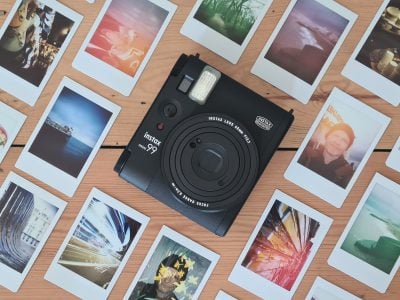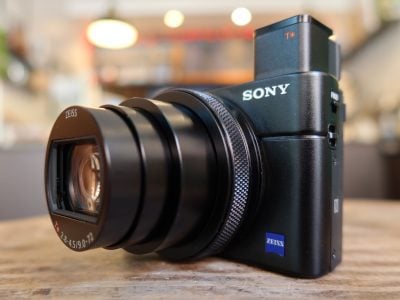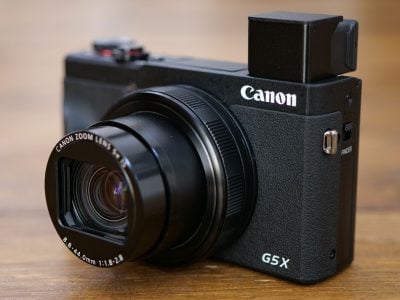Panasonic Lumix DMC-FX35
-
-
Written by Gordon Laing
Panasonic Lumix DMC-FX35 verdict
The Panasonic Lumix DMC-FX35 is a highly desirable slim, light and well-built compact camera with unusually wide angle coverage. Sporting 25-100mm equivalent coverage, it zooms much wider than the typical 36 or 38mm of most compacts and even squeezes-in slightly more than Panasonic’s own 28mm models, including the earlier FX33. It’s a very welcome facility.
In terms of the other new features, the HD video recording facility certainly produces footage with greater detail than the standard definition modes and it’s nice to have an optional Component video cable to view them (and slideshows) on an HDTV.
But like all video modes on still cameras, don’t expect miracles. The FX35’s HD recording may look better than its own SD modes, but it’s not a patch on a dedicated HD camcorder or even a higher-end SD model – and like most compacts, the audio is still pretty ropey. So it’s a nice feature to have, but still no replacement for a proper camcorder.
The enhanced Intelligent Auto mode now features Intelligent Exposure, although like the Lumix TZ5, it hardly made any impact on our test shots. But Intelligent Auto also includes the excellent Face and Scene Detection and Intelligent ISO features which continue to do an uncanny job of working out what you’re trying to take. Admittedly these were available on the earlier FX33, but they remain some of the most foolproof auto modes we’ve tested.
As for the boost in resolution, the extra two Megapixels may be measurable in lab tests, but don’t expect to notice much difference with real-life subjects. Like its predecessor, there’s also no manual control over shutter and aperture, and importantly, noise artefacts remain an issue – indeed if you’re looking very closely, they’re arguably slightly worse than the FX33, especially at higher sensitivities.
As usual, you’d be advised to stick with the lowest sensitivities, and even then, pixel peepers will notice texturing from noise and noise artefacts even at 100 ISO. It’s certainly not the model for someone who loves examining images on-screen at 100% or making big prints, but then to be fair, most compacts suffer in this regard. So before wrapping up, how does the FX35 compare to the competition?
Compared to Panasonic Lumix DMC-FX33
The Lumix FX33 is the FX35’s predecessor, and there’s only six months between them. Both share the same physical design, so with the FX33 you also get a slim, light and well-built compact. The FX33’s lens may not zoom quite as wide as the new FX35, but it still offers respectable 28mm equivalent coverage, and both cameras zoom-into the same 100mm. The FX33 is missing the HD recording of the FX35, but its 848×480 pixel mode produces decent results, and as a mid-2007 model, its Intelligent Auto mode is only missing out on the latest Intelligent Exposure enhancement – which in our tests was the least effective part of the entire system. So the FX33 may not have the FX35’s 25mm coverage, HD recording, Intelligent Exposure and optional HD output, but remains a desirable slim compact with 28mm coverage, while the two Megapixels difference is hardly noticeable in real life. At the time of writing, the FX33 typically cost around 20% less than the FX35 – not a huge difference, but if you’re on a strict budget it’s certainly well worth considering. See our Panasonic Lumix DMC-FX33 review for more details. |
Compared to Panasonic Lumix DMC-TZ5
Anyone shopping for a decent compact should consider Panasonic’s Lumix TZ5, which packs superzoom coverage into a pocketable form factor. Sure, the TZ5 may not be the slimmest compact on the market and looks relatively hefty compared to the FX35, but how many compacts can boast 10x 28-280mm coverage with stabilisation? The TZ5 also has a bigger and more detailed 460k 3in screen compared to the FX35’s 230k 2.5in model. In terms of electronics, the TZ5 and FX35 actually share the same sensor, although the TZ5’s optics mean ‘only’ 9.1 Megapixels of it are effective – you won’t notice any difference between them in real life though. Both models also share similar features with HD movie recording and Panasonic’s latest Intelligent Auto mode. So it’s a case of weighing up the much longer lens and bigger detailed screen of the TZ5 against the smaller and lighter FX35 which zooms slightly wider and also comes in around 20% cheaper. See our Panasonic Lumix DMC-TZ5 review for more details. |
Compared to Canon Digital Ixus 860IS / PowerShot SD870 IS
For roughly the same money as the FX35, you could alternatively buy Canon’s Digital Ixus 860 IS / PowerShot SD870 IS. In terms of core specifications, the Canon has 8 Megapixels, a stabilised 28-105mm lens range and a 3in screen, while the Panasonic FX35 has 10.1 Megapixels, a stabilised 25-100mm zoom and a 2.5 in screen. In real life you won’t notice much difference between 8 and 10 Megapixels in terms of recorded detail, although in our view the Canon delivered superior results at higher sensitivities. The bigger screen of the Canon is nice to have, but then so are the HD movies, HD output and arguably cleverer auto modes of the Panasonic. The slightly different lens range of each camera is a personal choice. So it’s a case of weighing up the features, and as crucially, which model you prefer the look and feel of – the Panasonic is smaller, but both are excellent models. See our Canon Digital Ixus 860IS / PowerShot SD870 IS review for more details. |
Panasonic Lumix DMC-FX35 final verdict
With only six months between the FX35 and its predecessor, Panasonic could have simply increased the resolution and improved the auto mode, but we’re pleased to also find a brand new lens with unusually wide angle coverage and HD video recording capabilities. The HD mode may be no replacement for a proper camcorder, but it’s still impressive, while the wider angle lens is a genuine boon in practice.
The higher resolution sensor really is unnecessary though. There’s barely any difference in real life detail, but arguably slightly worse noise levels. Beyond smaller photo-sites, this could also be down to different sensor design not to mention image processing, but if you look very closely, there’s definitely an edge to the earlier FX33. That said, it’s not so much that you’d choose one over the other in practice – we just wish the manufacturers would stop racing for ever-higher resolutions for marketing purposes when there’s a steady compromise in quality as a result.
Increased sensor resolution aside though, the FX35 features genuine improvements over what was already a decent compact, and its target market will find it well worth the asking price. So if you’re in the market for a slim, light compact that’s smart in both senses of the term, it should definitely be on your shortlist. And so long as you’re aware of the noise issues at higher sensitivities, we can Highly Recommend it, although do seriously compare the other models listed above as they may have a more compelling feature-set for your requirements.
|
Good points Bad points |
Scores (relative to 2008 compacts) |
 | ||
Build quality: Image quality: Handling: Specification: Value:
Overall: | 18 / 20 16 / 20 16 / 20 18 / 20 18 / 20
86% | |||
Support this site by checking prices above or shopping via our affiliate stores | ||||







